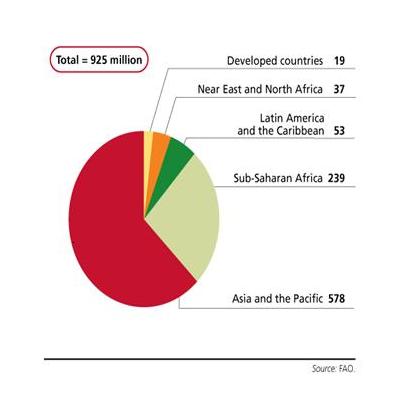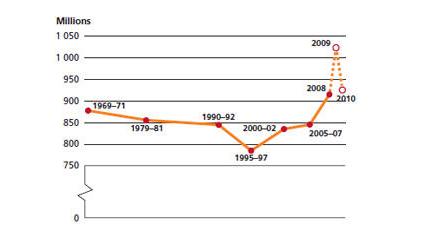
HUNGER as the EFFECTS of POVERTY
Meaningful long-term alleviation of hunger is rooted in the alleviation of poverty, as poverty leads to hunger. World hunger is a terrible symptom of world poverty. If efforts are only directed at providing food, or improving food production or distribution, then the structural root causes that create hunger, poverty and dependency would still remain. While resources and energies are deployed to relieve hunger through technical measures such as improving agriculture, and as important as these are, inter-related issues such as poverty means that political solutions are likely required as well for meaningful and long term hunger alleviation.
SOURCE: Anup ShahThis Page Last Updated Sunday, August 22, 2010
------
Causes of Hunger are related to Poverty
Consider the following:
-Over 9 million people die worldwide each year because of hunger and malnutrition. 5 million are children.
-Approximately 1.2 billion people suffer from hunger (deficiency of calories and protein);-Some 2 to 3.5 billion people have micronutrient deficiency (deficiency of vitamins and minerals);
-Yet, some 1.2 billion suffer from obesity (excess of fats and salt, often accompanied by deficiency of vitamins and minerals);
Food wastage is also high:
-In the United Kingdom, "a shocking 30-40% of all food is never eaten;" In the last decade the amount of food British people threw into the bin went up by 15%;-Overall, £20 billion (approximately $38 billion US dollars) worth of food is thrown away, every year.
-In the US 40-50% of all food ready for harvest never gets eaten Of the food that does eventually reach households, some 14% is wasted, resulting in something like $43 billion of wastage
-If food reaching supermarkets, restaurants and cafeterias is added to the household figure, that wastage goes up to 27%.
In Sweden, families with small children throw out about a quarter of the food they buy
The impacts of this waste is not just financial. Environmentally this leads to: -Wasteful use of chemicals such as fertilizers and pesticides;-More fuel used for transportation;
-Reducing wastage in the US by half could reduce adverse environmental impacts by 25 percent through reduced landfill use, soil depletion and applications of fertilizers, pesticides and herbicides.
-The direct medical cost of hunger and malnutrition is estimated at $30 billion each year.
SOURCE: Anup ShahThis Page Last Updated Sunday, October 03, 2010
2011 World Hunger and Poverty Facts and Statistics
Hunger is a term which has three meanings (Oxford English Dictionary 1971) the uneasy or painful sensation caused by want of food; craving appetite. Also the exhausted condition caused by want of food the want or scarcity of food in a country a strong desire or craving
Number of hungry people in the world: 925 million hungry people in 2010
No one really knows how many people are malnourished. The statistic most frequently cited is that of the United Nations Food and Agriculture Organization, which measures 'undernutrition'. The FAO did not publish an estimate in its most recent publication, 'The State of Food Insecurity in the World 2011' as it is undertaking a major revision of how it estimates food insecurity (FAO 2011 p. 10). The 2010 estimate, the most recent, says that 925 million people were undernourished in 2010 (FAO 2010). As the figure below shows, the number of hungry people has increased since 1995-97.. The increase has been due to three factors: 1) neglect of agriculture relevant to very poor people by governments and international agencies; 2) the current worldwide economic crisis, and 3) the significant increase of food prices in the last several years which has been devastating to those with only a few dollars a day to spend. 925 million people is 13.6 percent of the estimated world population of 6.8 billion. Nearly all of the undernourished are in developing countries.
-Number of hungry people, 1969-2010:
In round numbers there are 7 billion people in the world. Thus, with an estimated 925 million hungry people in the world, 13.1 percent, or almost 1 in 7 people are hungry.
According to the most recent estimate that Hunger Notes could find, malnutrition, as measured by stunting, affects 32.5 percent of children in developing countries--one of three (de Onis 2000). Geographically, more than 70 percent of malnourished children live in Asia, 26 percent in Africa and 4 percent in Latin America and the Caribbean. In many cases, their plight began even before birth with a malnourished mother. Under-nutrition among pregnant women in developing countries leads to 1 out of 6 infants born with low birth weight. This is not only a risk factor for neonatal deaths, but also causes learning disabilities, mental, retardation, poor health, blindness and premature death.
Does the world produce enough food to feed everyone?
The world produces enough food to feed everyone. World agriculture produces 17 percent more calories per person today than it did 30 years ago, despite a 70 percent population increase. This is enough to provide everyone in the world with at least 2,720 kilocalories (kcal) per person per day according to the most recent estimate that we could find.(FAO 2002, p.9). The principal problem is that many people in the world do not have sufficient land to grow, or income to purchase, enough food.
What are the causes of hunger?
What are the causes of hunger is a fundamental question, with varied answers.Poverty is the principal cause of hunger. The causes of poverty include poor people's lack of resources, an extremely unequal income distribution in the world and within specific countries, conflict, and hunger itself. As of 2008 (2005 statistics), the World Bank has estimated that there were an estimated 1,345 million poor people in developing countries who live on $1.25 a day or less.3 This compares to the later FAO estimate of 1.02 billion undernourished people. Extreme poverty remains an alarming problem in the world's developing regions, despite some progress that reduced "dollar--now $1.25-- a day" poverty from (an estimated) 1900 million people in 1981, a reduction of 29 percent over the period. Progress in poverty reduction has been concentrated in Asia, and especially, East Asia, with the major improvement occurring in China. In Sub-Saharan Africa, the number of people in extreme poverty has increased. The statement that 'poverty is the principal cause of hunger' is, though correct, unsatisfying. Why then are (so many) people poor? The next section summarizes Hunger Notes answer.
Harmful economic systems are the principal cause of poverty and hunger. Hunger Notes believes that the principal underlying cause of poverty and hunger is the ordinary operation of the economic and political systems in the world. Essentially control over resources and income is based on military, political and economic power that typically ends up in the hands of a minority, who live well, while those at the bottom barely survive, if they do. We have described the operation of this system in more detail in our special section on Harmful economic systems.
Conflict as a cause of hunger and poverty. At the end of 2005, the global number of refugees was at its lowest level in almost a quarter of a century. Despite some large-scale repatriation movements, the last three years have witnessed a significant increase in refugee numbers, due primarily to the violence taking place in Iraq and Somalia. By the end of 2008, the total number of refugees under UNHCR's mandate exceeded 10 million. The number of conflict-induced internally displaced persons (IDPs) reached some 26 million worldwide at the end of the year . Providing exact figures on the number of stateless people is extremely difficult But, important, (relatively) visible though it is, and anguishing for those involved conflict is less important as poverty (and its causes) as a cause of hunger. (Using the statistics above 1.02 billion people suffer from chronic hunger while 36 million people are displaced [UNHCR 2008])
Hunger is also a cause of poverty, and thus of hunger. By causing poor health, low levels of energy, and even mental impairment, hunger can lead to even greater poverty by reducing people's ability to work and learn, thus leading to even greater hunger.
Climate change Climate change is increasingly viewed as a current and future cause of hunger and poverty. Increasing drought, flooding, and changing climatic patterns requiring a shift in crops and farming practices that may not be easily accomplished are three key issues. See the Hunger Notes special report: Hunger, the environment, and climate change for further information, especially articles in the section: Climate change, global warming and the effect on poor people such as Global warming causes 300,000 deaths a year, study says and Could food shortages bring down civilization?

